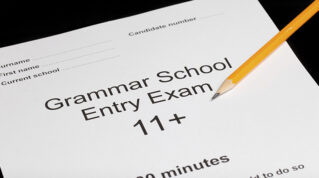The disadvantage gap between grammar schools handed £64 million to become more inclusive and their non-selective neighbours has widened.
In 2018, 16 grammar schools were given about £50 million to expand. A further six split another £14.3 million in 2019. In exchange, they had to put plans in place to recruit more disadvantaged pupils.
Despite a pandemic surge in the number of pupils eligible for free school meals, figures from the campaign group Comprehensive Future show that grammars have fallen further behind on inclusivity.
The difference between the number of pupils on free school meals across the 22 grammars and their non-selective neighbours grew from 12.2 percentage points to 16.8 in just two years, a rise of 38 per cent.
Although the average free school meals rate in the schools rose from 3.2 per cent in 2019 to 5.2 per cent in 2021, the proportion of pupils eligible for free meals at non-selective schools in the same areas increased from 15.4 to 22 per cent.
For some schools, the increase in the disadvantage gap was substantial. It rose from 16.3 to 27.2 percentage points at Haberdashers’ Adams school in Shropshire, and from 16.2 percentage points to 27 at the nearby Newport Girls’ High School Academy.
Most of the 22 grammars were also more likely to admit pupils from fee-paying prep schools than those from disadvantaged backgrounds.
Expansion fund ‘fundamentally flawed’
Dr Nuala Burgess, the chair of Comprehensive Future, said the figures showed the expansion fund was a “fundamentally flawed idea”.
“When you think how much money was given to grammar schools on the condition of widening their access, these figures are shocking.”
But leaders said they were starting to see the fruits of their efforts, especially in younger age groups.
At Bournemouth School, the proportion of pupils eligible for free school meals more than doubled from 2.8 per cent in 2019 to 6 per cent in 2021. But the disadvantage gap rose from 10.7 to 14.3 percentage points, because the free school meals rate in other local schools also rose.
Dorian Lewis, Bournemouth’s head, said changes to admissions policies “only impact upon a proportion of the school population, not those in older year groups who were admitted under an older policy”.
At nearby Bournemouth School for Girls, the proportion of pupils eligible for free school meals also rose, from 2.7 per cent to 4.8 per cent, but its gap increased from 10.8 to 15.5 percentage points.
Covid affected grammar schools’ outreach work
Alistair Brien, its head, said the school remained “absolutely committed to widening access”. But initiatives planned for the past year were shelved because of Covid.
The number of pupils eligible for free school meals at St Michael’s Catholic Grammar School in Barnet, north London, rose from 2.8 per cent to 4.4 per cent over the two years. Its gap rose from 12.4 to 14.4 percentage points.
Michael Stimpson, the schools’ head, pointed to rising rates of disadvantage in lower year groups.
There was also “no doubt at all that lockdown has prevented us from fully ‘getting out there’ and so numbers would be lower than we all hoped”.
The free schools meals rate at Lawrence Sheriff school in Warwickshire increased from 3.1 to 5.6 per cent, while its disadvantage gap rose from 8.8 to 11.8 percentage points.
Teresa Mpofu, Lawrence Sheriff’s head, said the school had prioritised disadvantaged pupils in its oversubscription criteria and lowered the 11-plus pass mark for poorer children.
But the school faced a “challenge” in ensuring information sent out through primary schools reached poorer families. “We do not have access to lists of such pupils, which would enable us to contact them directly.”
Two thirds of expansion funding remains unspent
A question mark also hangs over the future of the expansion fund. Less than a third of the £200 million has been handed out and no further rounds have been announced since 2019.
Dr Mark Fenton, the chief executive of the Grammar School Heads’ Association, said there was “much more work to do”.
A free test familiarisation service for poorer pupils, piloted in 30 schools last year, is now being rolled out nationally.
Fenton said children from poorer backgrounds performed less well than their peers “at every level of education in England”.
“It’s hardly surprising that only a few of them achieve well enough in primary school to put themselves in contention for a grammar school.”
However, poorer children do “substantially” better at grammar schools, “so every extra child we can welcome into one of our schools is a bonus”.
















Your thoughts